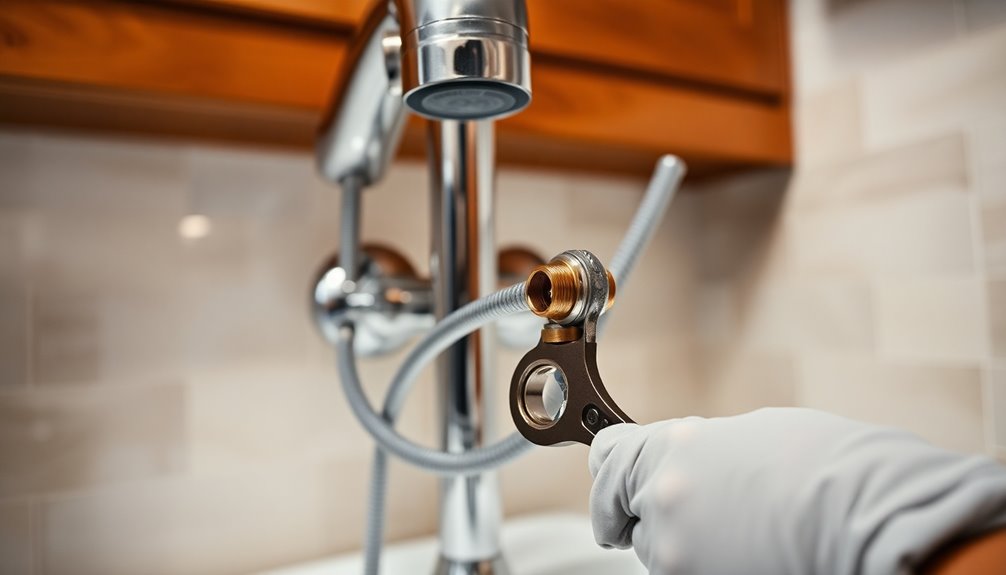To extend your faucet supply line, first turn off the water at the shut-off valve. Disconnect the existing supply line with an adjustable wrench. Measure the distance to determine the length you need for the new hose, ensuring it has the right fittings. Connect the new extension using Teflon tape on threaded connections. Finally, turn the water back on and check for leaks. Keep going to discover more detailed steps and tips for a successful installation!
Key Takeaways
- Measure the distance from the shut-off valve to the faucet to determine the required length of the extension hose.
- Turn off the water supply at the shut-off valve to prevent leaks during the installation process.
- Disconnect the existing supply line using an adjustable wrench and prepare to attach the new extension.
- Connect the new extension hose using compatible compression fittings and apply Teflon thread sealant tape to prevent leaks.
- After installation, gradually turn on the water and check for leaks, tightening connections as necessary.
Understanding Faucet Hose Extensions

Understanding faucet hose extensions can make your plumbing projects much smoother, especially when your existing supply lines just won't reach.
These extensions, typically made of durable materials like stainless steel, come in lengths from 12 to 72 inches. This variety helps you connect standard kitchen faucets to water supply lines effectively.
When choosing a faucet hose extension, it's essential to measure the distance between your faucet and the water supply accurately. This guarantees you buy the right length.
Remember, proper installation is key, so you'll want to use tools like an adjustable wrench and Teflon thread sealant tape.
After installation, always test for leaks to make certain everything's secure and functioning properly, preventing any unwanted water damage.
Tools Required for Installation
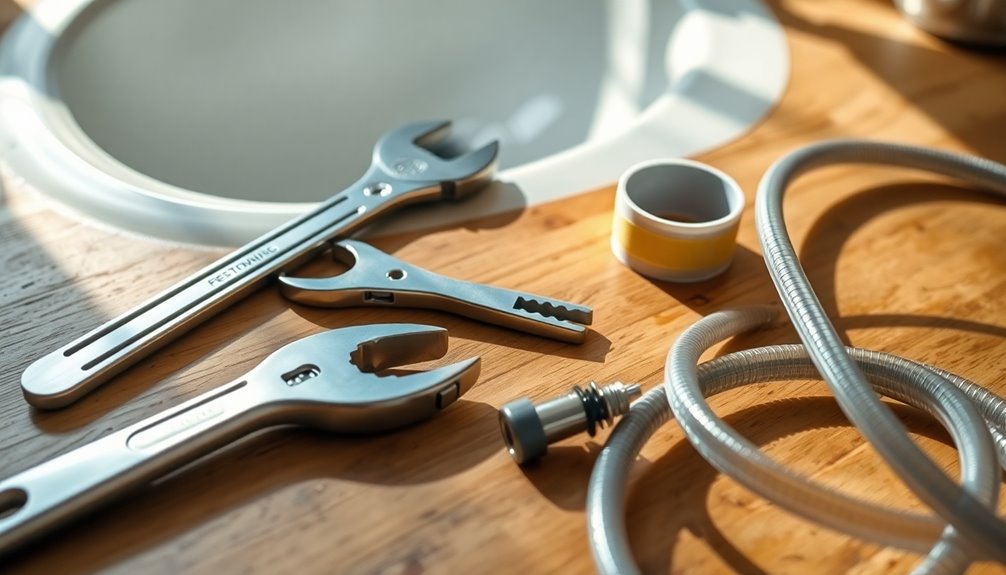
When extending your faucet supply line, you'll need a few essential tools to get the job done smoothly.
Make sure you have safety equipment on hand and gather commonly used materials to prevent any mishaps.
With the right tools, you'll tackle the installation like a pro.
Essential Plumbing Tools Needed
To successfully extend your faucet supply line, you'll need a few essential plumbing tools.
First, grab an adjustable wrench, which is vital for disconnecting and connecting supply lines without damaging the pipes.
Next, Teflon thread sealant tape is a must-have to prevent leaks at threaded connections, ensuring a watertight seal.
You'll also require a faucet hose extension, available in lengths from 12 inches to 72 inches, to accommodate your needs.
Compression adapters may be necessary to connect different supply line sizes, ensuring compatibility.
Finally, keep an empty bucket handy to catch any leaking water during installation, helping you maintain a clean workspace and avoid water damage.
With these tools, you'll be well-prepared for the task ahead!
Safety Equipment for Installation
Before diving into your faucet supply line extension, it's important to prioritize safety by using the right equipment. An adjustable wrench is a must-have for safely disconnecting and reconnecting the supply lines.
You'll also want to grab some Teflon thread sealant tape to apply on threaded connections, preventing leaks after installation.
Don't forget a faucet hose extension, available in various lengths, to effectively lengthen your supply lines between the faucet and shut-off valves.
If your supply lines vary in size, a compression adapter will guarantee a secure fit.
Finally, keep an empty bucket nearby to catch any residual water, minimizing mess and making sure your workspace stays safe.
With these tools, you'll be well-prepared for your project!
Commonly Used Materials
Having the right safety equipment sets the stage for a successful faucet supply line extension, but it's equally important to focus on the materials you'll need for the installation.
For durable and reliable supply lines, opt for stainless steel or braided nylon hoses, as they're resistant to kinks and leaks. You'll also need an adjustable wrench to securely disconnect and reconnect your supply lines.
Don't forget Teflon thread sealant tape; it guarantees a watertight seal at threaded connections. If your hoses vary in size, compression adapters will help you connect them seamlessly.
Finally, keep an empty bucket nearby to catch any residual water during the disconnection and installation process, making cleanup easier.
Measuring the Required Length
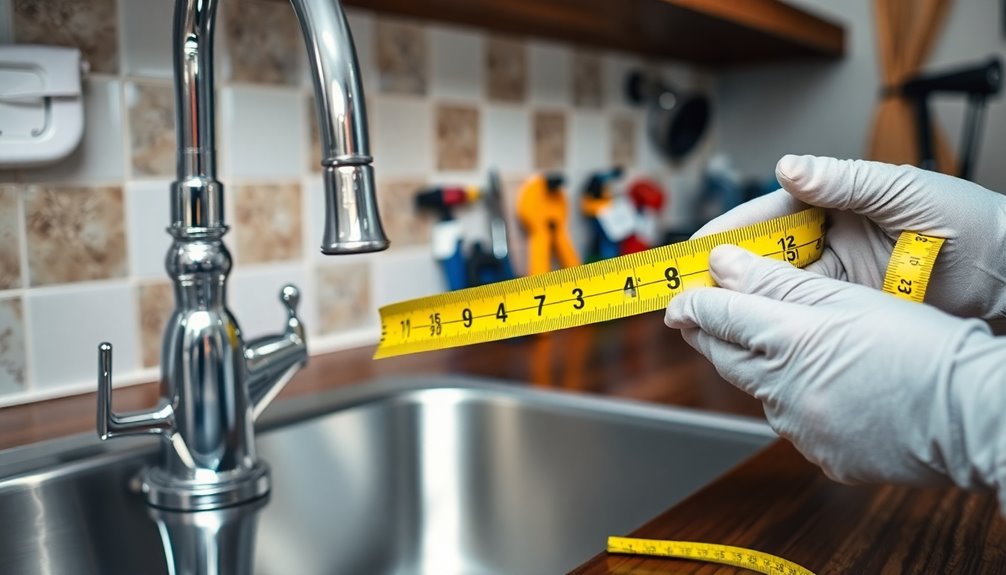
When you're ready to extend your faucet supply line, measuring the required length accurately is crucial for a successful installation.
Start by measuring the distance from the shut-off valve to the faucet connection, and don't forget to add an extra inch for flexibility. Use a tape measure for precision and gauge the total length needed for the extension.
If there's a height difference between the shut-off valve and the faucet, make certain to account for that vertical run in your measurements.
If the faucet location is adjustable, re-measure after any changes to confirm you have the correct length.
Always double-check your measurements before purchasing additional supply lines to avoid overbuying or underestimating what's needed.
Step-by-Step Installation Process
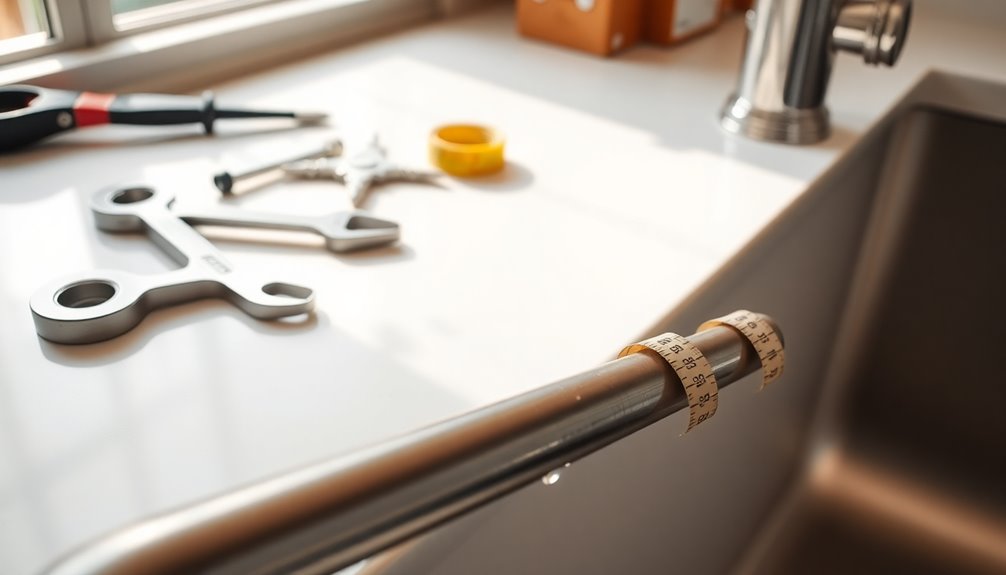
With your measurements in hand, it's time to start the installation process for extending your faucet supply line. Follow these steps for a smooth installation:
| Step | Action | Tools Needed |
|---|---|---|
| 1 | Turn off the water supply at the shut-off valve | None |
| 2 | Disconnect the existing supply line from the faucet | Adjustable wrench, bucket |
| 3 | Measure the extension length and purchase a compatible hose | Tape measure, hose |
| 4 | Connect the new extension to the existing supply line | Compression fittings, wrench |
Secure all connections without over-tightening. Once everything's connected, turn the water back on and check for leaks, tightening as needed to guarantee a proper seal. You're all set with your extended supply line!
Turning Off the Water Supply
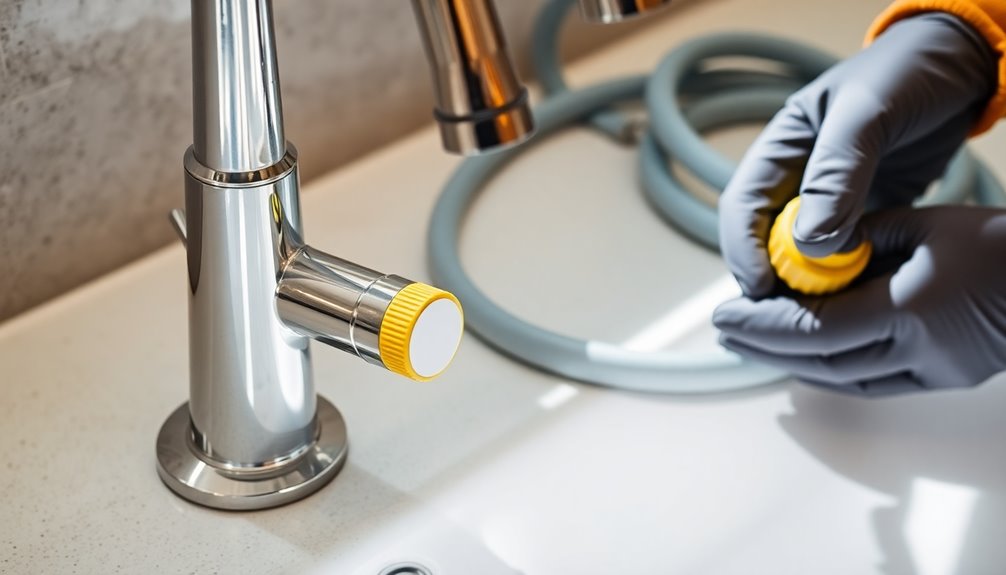
Before you start extending your faucet supply line, you'll need to locate the shut-off valve under the sink.
Turn it clockwise to guarantee the water is completely off.
Once you've done that, test the faucet to confirm there's no water flow.
Locate Shut-Off Valve
To successfully extend your faucet supply line, you first need to locate the shut-off valve, which is usually found under the kitchen sink.
This valve is essential for stopping the water flow before you begin any plumbing work. Check for both shutoff valves, as there might be one for hot water and another for cold.
To turn off the water supply, rotate the shut-off valve clockwise until it stops. If you find it difficult to turn, use pliers for a better grip, but don't apply excessive force to avoid damaging the valve.
Once the water is off, always inspect for leaks or drips to verify the shut-off valves are functioning properly before proceeding with your project.
Ensure Water Is Off
Ensuring the water is off is essential before you start extending the faucet supply line.
Locate the shut-off valve under the sink and turn it clockwise to stop the water supply completely. This step is important to prevent leaks or flooding during your work.
If there's no shut-off valve, you'll need to turn off the main water supply to your home for safety.
After shutting off the valve, always check that the water supply is indeed off by turning on the faucet; no water should flow.
Keep a bucket or towel handy to catch any residual water that might spill out when you disconnect the supply lines.
Taking these precautions will help you work confidently and safely.
Disconnecting the Existing Supply Line
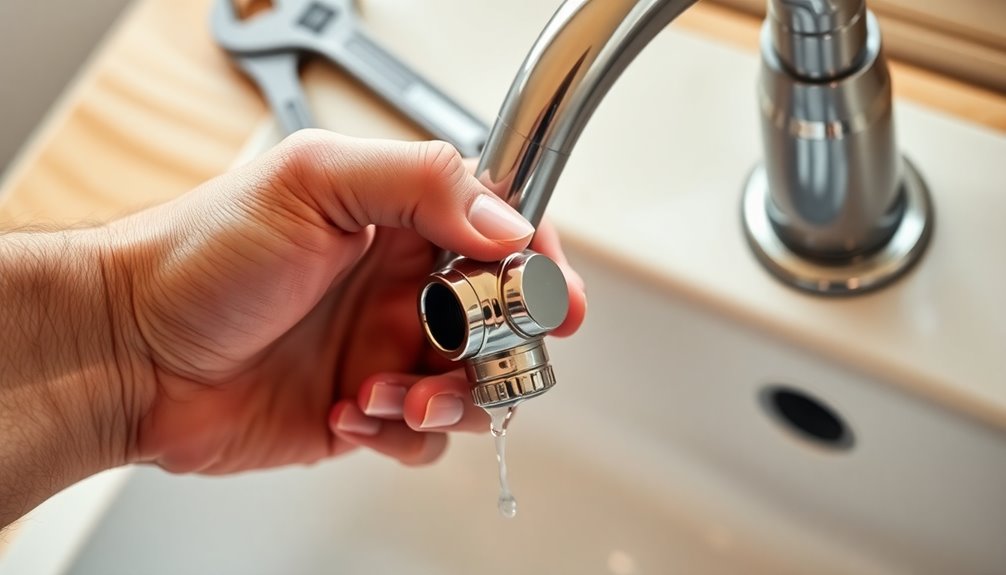
Disconnecting the existing supply line is a crucial step in extending your faucet supply line.
Start by turning off the water supply at the shutoff valve under the sink to avoid any leaks.
Next, use an adjustable wrench to loosen the connection between the supply line and faucet, turning counterclockwise until it's easy to remove.
If your supply line connects to a compression fitting, gently compress the fitting while twisting the supply line to detach it.
Make certain to place an empty bucket underneath to catch any residual water that may spill during this process.
After you've removed the supply line, inspect the threads and seals for damage to guarantee a proper fit when you install the new extension.
Installing New Faucet Supply Lines
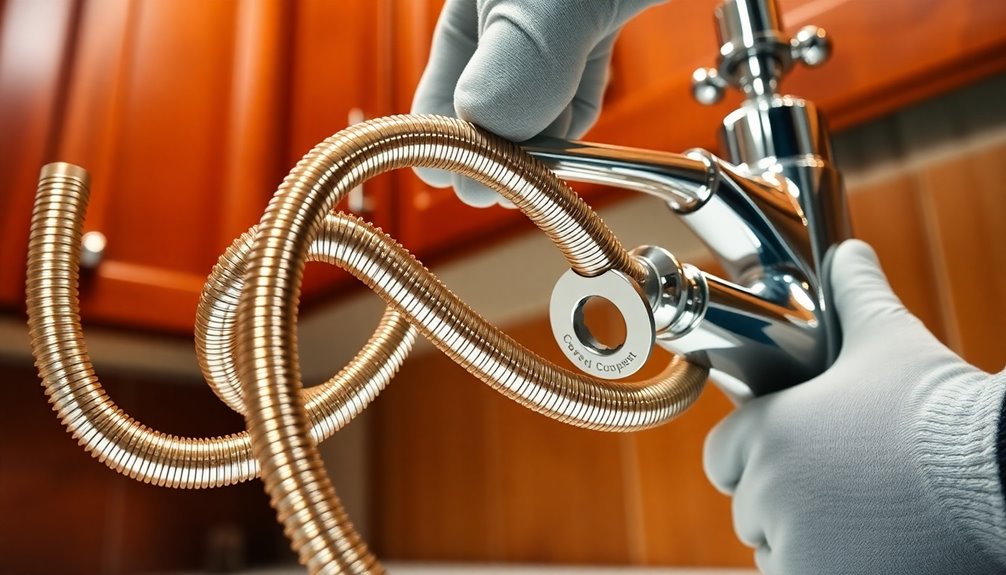
After removing the old supply line, it's time to install the new faucet supply lines. First, measure the distance from your faucet to the shut-off valves to determine the required length of the new lines.
Once you've got the right measurements, follow these steps:
- Purchase flexible faucet supply lines that fit your existing connections, typically available in lengths from 12 to 72 inches.
- Use 3/8 inch compression unions to connect the new supply lines to the existing ones for a secure, leak-proof fit.
- Don't forget to apply Teflon thread sealant tape on threaded connections to prevent leaks.
Finally, turn off the water supply before you start and test for leaks once everything's connected.
Connecting the Supply Lines
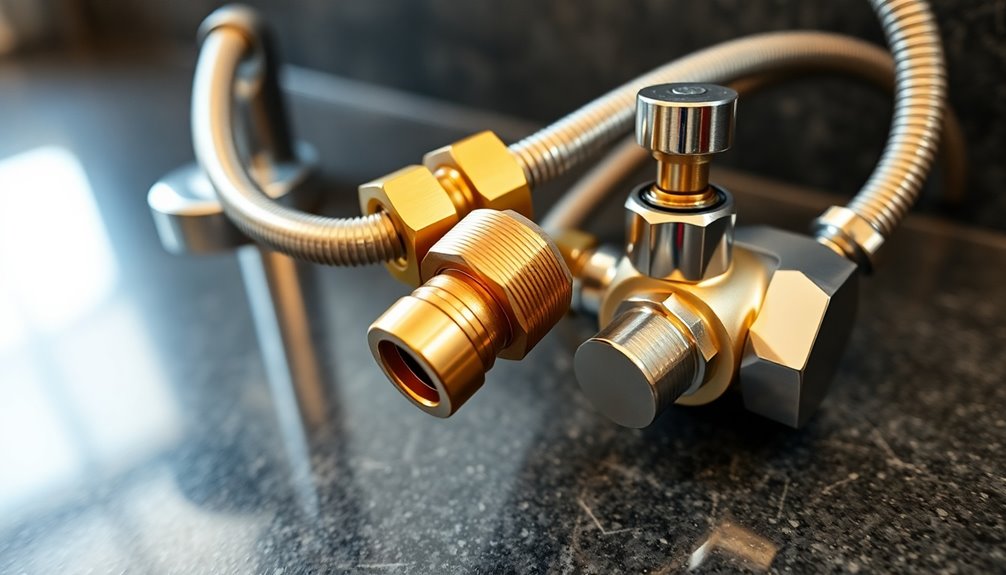
When connecting the supply lines, make sure you have the right tools on hand, like adjustable wrenches and compression adapters.
You'll also want to double-check that all hoses are compatible with your faucet to prevent any leaks.
With everything ready, you can confidently tighten those connections for a secure fit.
Necessary Tools Needed
To successfully connect the supply lines, you'll need a few essential tools that guarantee a smooth installation process. Here's what you should gather:
- Adjustable Wrench: This is vital for securely disconnecting and connecting the supply lines, preventing leaks during installation.
- Teflon Thread Sealant Tape: Use this on threaded connections to assure a watertight seal and minimize the risk of leaks.
- Faucet Hose Extension: Choose one made of durable materials like stainless steel, based on the required distance.
Additionally, consider having a compression adapter if the existing supply line sizes differ.
Don't forget an empty bucket to catch any residual water while you work.
With these tools, you'll be set to extend your faucets' water supply lines effectively!
Ensuring Proper Compatibility
Connecting the supply lines requires careful attention to compatibility between your existing lines and any new extensions. Make certain the connector types match; different faucet brands may use non-standard fittings.
Most standard faucet supply lines are 3/8 inch compression sizes, so check that the new hoses you buy conform to this standard. If you're connecting new hoses to existing faucet hoses, you might need compression unions or adapters to guarantee a proper fit and seal.
Always measure the distance from the faucet to the shut-off valves accurately to select an extension length that minimizes strain and avoids kinks.
Finally, before installation, gradually turn on the water supply and inspect all connections for any potential leaks or misalignment.
Testing for Leaks
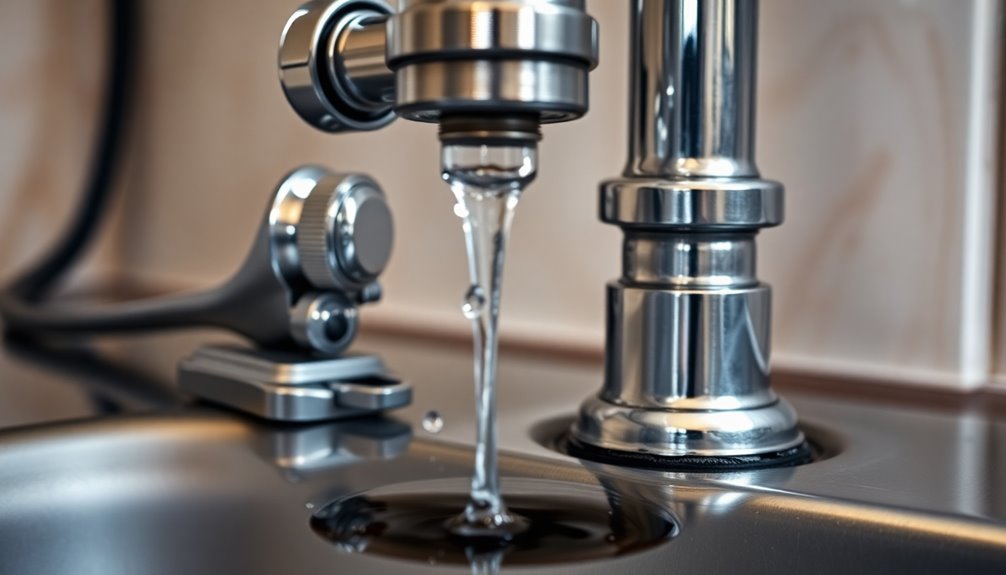
After installing your extended faucet supply lines, it's crucial to test for leaks to guarantee everything is functioning properly.
Follow these steps to verify your water lines are leak-free:
- Gradually turn on the water supply and observe the connection points for any signs of leaks.
- Use a towel or cloth to wipe around the connections, checking for moisture.
- If you detect any leaks, tighten the connections slightly with an adjustable wrench, but be cautious not to overtighten.
For added security, consider applying Teflon thread sealant tape on threaded connections.
Regularly inspect the supply lines for wear or leaks, especially if the faucet is frequently used, to maintain long-term reliability and functionality.
Tips for Ensuring Compatibility
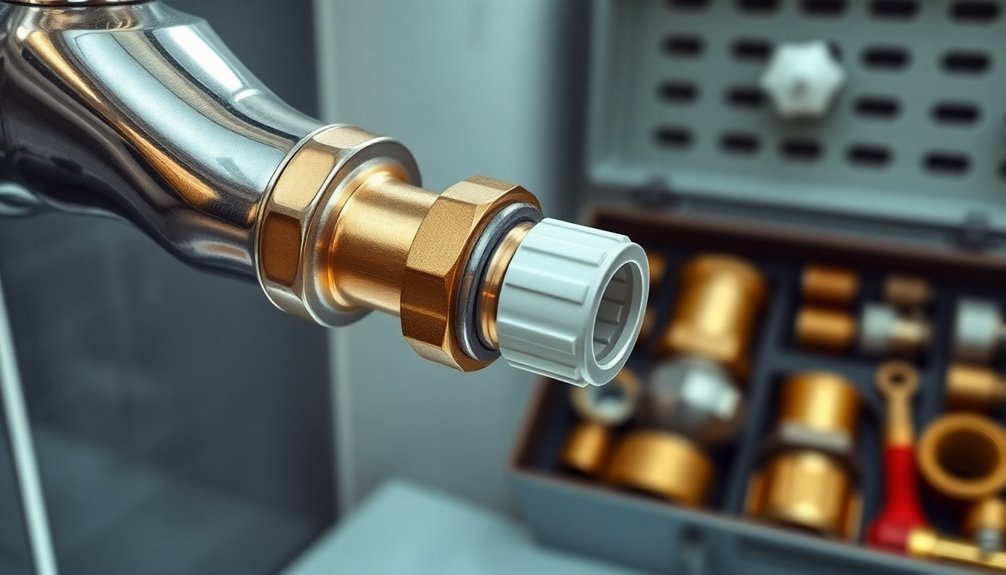
Guaranteeing compatibility when extending faucet supply lines is essential for a successful installation.
Start by measuring the distance from your faucet to the shut-off valves, so you can get the right length for your supply line extension.
Check that the existing supply line connectors match the new hoses; Ikea faucets often require specific adapters due to their non-standard connectors.
Use standard 3/8 inch compression fittings to guarantee a solid connection to existing water lines.
Always verify the pressure rating of your extension hoses to prevent bursting under pressure.
Finally, opt for braided stainless steel supply lines, as their durability and flexibility make them ideal for achieving a proper fit while extending your supply lines effectively.
Frequently Asked Questions
Can You Extend a Faucet Water Line?
Yes, you can extend a faucet water line.
You'll find compatible supply line extensions or hoses at home improvement stores, usually ranging from 12 to 72 inches.
Just make certain the connectors match your faucet's existing fittings, which can vary.
Before you start, turn off the water supply to avoid leaks.
After you install the extension, turn the water back on and check for any leaks at the connections to ascertain everything's sealed properly.
What to Do if Faucet Supply Lines Are Too Short?
If your faucet supply lines feel like they're tethered too short, it's time to set them free!
First, measure the distance to guarantee you get the right length. You can find longer supply lines that fit snugly with your faucet.
Consider using compression unions for a secure connection.
Don't forget to turn off the water and apply Teflon tape to threaded joints.
How Do You Make a Homemade Faucet Extender?
To make a homemade faucet extender, grab a flexible tubing that matches your existing supply line's diameter, usually 3/8 inch.
Cut the tubing to the needed length, ensuring it fits snugly from the shut-off valve to the faucet.
Use compatible compression fittings or hose clamps to secure the ends.
Wrap Teflon tape around threaded connections to prevent leaks.
Finally, turn on the water slowly and check for leaks to confirm everything's working properly.
Does the Length of a Water Supply Line Matter?
Imagine a river winding through a valley; the longer it flows, the weaker its current becomes.
Similarly, the length of your water supply line matters. Longer lines can lead to decreased water pressure due to friction loss, making that invigorating water flow less satisfying.
To keep your faucet working like a well-oiled machine, you'll want to keep those lines short and sweet, ensuring they deliver a strong, steady stream when you need it.
Conclusion
By following these steps, you can easily extend your faucet supply line and guarantee a steady water flow. Imagine a scenario where you've just remodeled your kitchen, but the existing supply lines don't reach your new sink. With the right tools and a bit of patience, you can tackle this project yourself, saving money on professional help. Remember, a little DIY effort can lead to big improvements in your home's functionality and style!
